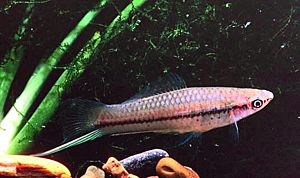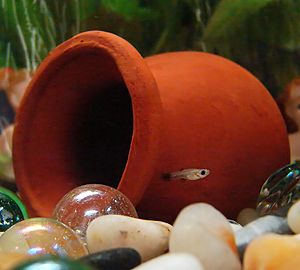Poeciliidae facts for kids
Quick facts for kids Poeciliidae |
|
|---|---|
 |
|
| Green swordtail, Xiphophorus hellerii | |
| Scientific classification |
|
| Kingdom: | Animalia |
| Phylum: | Chordata |
| Class: | Actinopterygii |
| Order: | Cyprinodontiformes |
| Superfamily: | Poecilioidea |
| Family: | Poeciliidae Bonaparte, 1831 |
| Subfamilies & Genera | |
|
See text |
|
The Poeciliidae are a group of freshwater fishes. They are often called "tooth-carps" and include many popular aquarium fish that give birth to live young. Some well-known examples are the guppy, molly, platy, and swordtail.
These fish originally lived in the southeastern United States, down to Argentina, and also in Africa, including Madagascar. Today, you can find poeciliids in warm parts of the world. This is because some aquarium fish were released into the wild. Also, certain types like Poecilia and Gambusia were used to control mosquitoes. They have even been found in hot springs as far north as Banff, Alberta in Canada!
How Poeciliidae Fish Reproduce
Most fish in the Poeciliidae family are known as "live bearers." This means the mother gives birth to tiny, fully formed fish, instead of laying eggs. However, some species, especially all the African ones, actually lay eggs. Most American species are live bearers.
Scientists think that the Poeciliidae family existed before Africa and South America split apart about 100 million years ago. This suggests that the ability to give birth to live young developed later in South America. These fish then spread to North America through islands that were once connected. Later, when South America connected to Central America, some fish moved further south.
How Mothers Support Their Babies
Among the live-bearing species, there are different ways mothers support their developing babies. Some are called lecithotrophic. This means the mother puts all the food the baby needs into the egg before it's fertilized. So, the baby grows using only the food stored in its egg.
Other species are matrotrophic, which means "mother feeding." In these cases, the mother provides most of the food and resources to her babies after the egg has been fertilized.
For example, some fish in the Poeciliopsis group show different levels of mother feeding.
- Poeciliopsis monacha is mostly lecithotrophic. The mother doesn't give much extra food after fertilization. She's like a "swimming egg sac."
- P. lucida provides some extra food. The baby's growth can affect the mother's body, allowing more nutrients to be shared.
- P. prolifica is highly matrotrophic. Almost all the food for the baby comes from the mother after fertilization.
This high level of mother feeding allows Poeciliopsis prolifica to carry several groups of babies at different stages of development. This is called superfetation. Giving birth to live young usually means fewer babies at a time because there's limited space inside the mother. Superfetation helps make up for this by letting the mother carry babies of various sizes and ages.
Other Poeciliopsis species, like P. elongata, P. turneri, and P. presidionis, are also very highly matrotrophic. They are so good at feeding their babies inside them that scientists have described special cells in the mother as a "pseudo-placenta."
See also
 In Spanish: Poecílidos para niños
In Spanish: Poecílidos para niños


